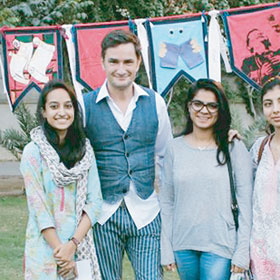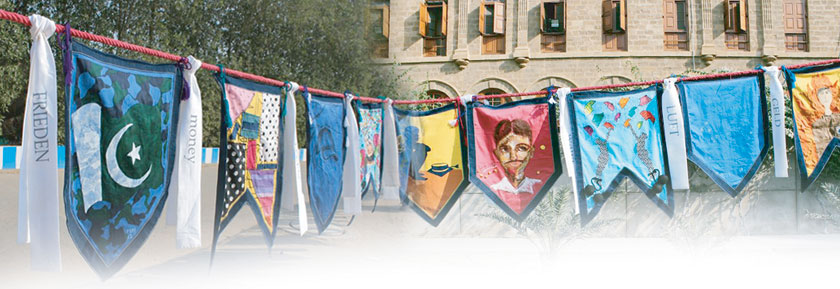Growing up with horses and studying theatre in College, Miro Craemer, a fashion artist from Munich has come a long way.
Weaving the tapestry of desires
Growing up with horses and studying theatre in College, Miro Craemer, a fashion artist from Munich has come a long way. He began his career with designing riding sports accessories and high fashion, but now calls himself a social designer.
Miro joined hands with the students of Iqra University and Indus Valley School of Arts and Architecture (IVS) to create his latest artwork ‘Cord of desires’ in Karachi, which is the manifestation of what he believes in. 
Us spoke to Miro Craemer about his artistic journey.
Us: What does it mean to be a social designer?
MC: It’s about combining the art of fashion with social issues. It sounds like a different approach because generally fashion is perceived as a means of selling clothes. For a social designer, fashion is a language one could speak with all the people; so, why not use it to express yourself?
Us: Your source of inspiration?
MC: If I have an idea in mind or I see a problem in the world that touches me in any way, I want to work on it. Few years back, I was struck by the political disturbances in Namibia, so I experimented with the forms and colours of that country in my fashion work. By making space for addressing socio-political issues, you make your artwork more meaningful.
Us: What is ‘Cord of desires’?
MC: It’s a social sculpture. According to German artist Joseph Beuys, everyone is an artist and if we engage people to find their creativity and bring them together, we can solve social problems.
‘Cord of desires’ is part of Urbanities - art and public space in Pakistan which is a collaboration between the Goethe-Institut Pakistan, Vasl Artists’ Collective and Lahore Biennale Foundation. When they called for participants, I immediately had the idea of Baldia Factory Fire incident.
The purpose was to unfold the inner greed of industrialists and consumers who wanted cheap clothes but never thought of the workers who produced them.
It’s all about desires: the desires of clients like me, who wish for inexpensive dresses, the desires of the companies who wanted more profit. But, in the rush to fulfill our desires, we neglect the desires of other human beings. That is why I decided to focus on the victims’ wishes, so that they stand out and remain visible.
While interviewing the victims’ families, I could sense the heaviness of their grief. Even after four years, their wounds are still fresh. Initially, they remained silent, but when asked for their loved ones’ unfulfilled wishes, they opened up:
‘I remember, my son always wanted to go the beach.’
‘He wanted a cap so that he could hide his fringes in it from his father who disliked men with long hair.’
These wishes sound simple and yet they were powerful enough to move me.
Students brought in their expertise to translate the data collected into small flags of denim fabric.
There is beautiful patchwork; the details were painted, embroidered or stitched. When the people come nearer to these pieces, they are confronted by the meaning conveyed by this social sculpture. Like the flag symbolizes sign of change – the change we want to bring in our society - and the fabric of denim reminds us of the jeans produced in the Ali Enterprises.
We have a flag that tells the story of a victim who was responsible for attaching buttons and sewing buttonholes in the jeans. When the fire broke out, he was half way through his work. To depict the victim’s unfulfilled wish, a student stitched buttons on the flag while leaving out some incomplete buttonholes.

Us: Why did you pick up Baldia factory incident as a theme for your artwork?
MC: It was a tragedy that really touched me in 2012. As a human being, it is not easy to think of hundreds of people burning alive in an enclosed factory.
Being a fashion designer, I always thought about the working conditions of the labour in South Asia. It was upsetting! The plight of these workers was hidden behind the glitz and glamour of the fashion world. This incident surfaced what was never seen by the people.
As a German fashion designer, I felt guilty for this because the Baldia factory manufactured jeans for a German company KiK; I have even greater responsibility.
This may not be enough, but at least the wind of change is starting to blow. The German company has granted a compensation of five million dollars to the victims. However, the company KiK now wants to produce jeans in Myanmar. I believe, if we push a little more, we can stir law enforcement agencies to take action and stop companies from exploiting human resources in the developing countries. So, industrialists and fashion companies could be held responsible for the security standards of their suppliers.
Us: Any flag that you hold very close to yourself?
MC: Yes, there is one! I interviewed a mother who told me it was her son’s birthday on September 11, 2012, and she baked him a cake that morning. His joy doubled when his mother told him that he would become a father. He went happily to the factory and died there in flames. We transformed this through stitching a nice cake, and the little child standing on the other side. When the exhibition of these flags was opened in IVS to the public, we showed this to the victim’s 4-year-old child and told him that it was him in the picture. It was an extremely touching moment.
Us: What is the philosophy behind your designs?
MC: I trust in community. I believe in the power of collaborative creativity because one alone is not able. I don’t mean to downplay the importance of an individual, but I am saying if we join together and bring in people, we can do wonders for ourselves and the society.
I think that the egoistic mindset is stopping us from becoming better human beings; In the future, I want to work on this and demonstrate this through my work.
Us: Career advice for young/aspiring artists?
MC: No matter what you do, it is important to understand the interdisciplinary nature of art. Art can’t be strictly compartmentalized; everything is connected in one way or another. If you are a textile designer, it doesn’t mean that you can’t experiment with miniature painting or graphics. In fact, there is no limitation to experimentation. For instance, fashion designing in itself encompasses several art forms and artistic techniques.
So break through your fixed ideas, think free and cross the borders. Step out from your fine arts department and say hello to someone in the fashion designing department, intermingle and be ready to work together!
Us: Message for the readers…
MC: We should all work on our individual greed and replace it with the love of humanity. We are always thinking of ways to get more and more profits. In doing so, we don’t realize what damage we cause to other people. It’s important that we give others a chance to live a happy and prosperous life.